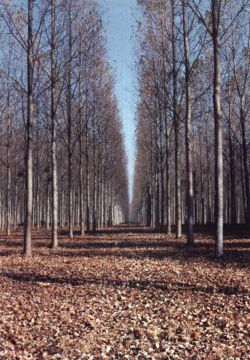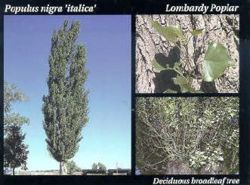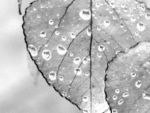Black poplar
| Black poplar |
|---|

|
| Scientific Classification |
|
| Binomial Name |
|
Populus nigra |
The Black Poplar is a deciduous tree also known as the Lombardy poplar. It is native to Europe, southwest and central Asia, and northwest Africa. It can grow up to 30 meters tall and often leans, giving it a distinctive shape.
Anatomy
The black poplar is a robust, broadly rounded tree which can grow to a height of 30 metres, with a crown of 20 metres and a trunk diameter of up to 250 cm. Mature trees are most easily recognized from a distance, especially in winter. They often lean at an angle and have dark grey deeply furrowed bark usually interrupted by large woody swellings or bosses. The crown is typically spreading, and old(er) trees often have down-curving branches upswept at tips.[1] Young leaves generally open in late April and are pale green, occasionally tinted bronze at first and have a distinct aroma. Mature leaves are mid-green, and variable in size and shape, but they usually have a cuneate base, and the leaf is longer than it is wide. The leaf margins are serrated but teeth are usually not hooked. They are also characterised by their large, often leaning and ungainly appearance with massively arching, down-curved branches and heavily burred trunks.[2]
Reproduction
Young leaves generally open in late April, are pale green, occasionally tinted bronze at first, and have a distinct aroma. Mature leaves are mid-green and variable in size and shape, but they usually have a cuneate base and the leaf is longer than it is wide. The leaf margins are serrated but teeth are usually not hooked. Petioles have no glands at the apex. The Black Poplar is dioecious (has male and female plants) and catkins appear before the leaves. Female trees occur throughout the distribution range in England but are rare in Wales, the male Catkins are crimson and appear in late March or early April. Female Catkins are yellow-green and appear shortly afterwards.[3]
Ecology
Black Poplars are found in wet woods and stream sides but becoming rare. Natural distribution is in mainly Eastern and Central England but across England to Cheshire. Possibly native in South and Center of Ireland. Native to most of Europe and Western Asia. However, the Black Poplar needs very specialised conditions in which to propagate. The seeds need to lie undisturbed on bare, wet mud or silt from June to October to germinate successfully. These conditions became harder to find as suitable habitats were lost. Black Poplar seeds have very exacting germination requirements and the drainage of winter flooded meadows has resulted in the loss of suitable land for seedling germination and establishment. Consequently, most of the remaining trees in Britain have probably been artificially propagated from cuttings; there is currently no natural regeneration from seed. [4]
 Browse |
Related References
- http://bioenergy.ornl.gov/misc/poplars.html
- http://www-saps.plantsci.cam.ac.uk/trees/poplarb.htm
- http://www.biodiversitysussex.org/blackpoplar.htm


